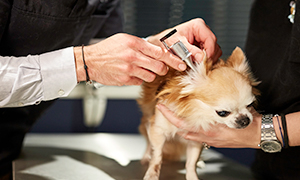Looking Deeper Into Chronic Otitis Externa

OE is defined as ‘inflammation of the external ear canal’, therefore it is not an absolute diagnosis, merely a symptom with multifactorial causes. The aetiological causes of OE may be divided into primary and secondary causes which result in inflammation, and perpetuating and predisposing factors.
Primary causes of OE can include allergy; most commonly atopic dermatitis, ectoparasites such as Otodectes cynotis and systemic diseases such as hypothyroidism. Failure to recognise and manage any primary cause of inflammation is the most common reason for recurrence and the subsequent development of chronic disease, therefore further investigations into underlying causes should ideally be discussed at an early stage and encouraged should the patient present repeatedly.
Fungal and bacterial infections are secondary causes of OE resulting from an altered environment within the ear canal which favours microbial overgrowth. It is important to note that whilst effective treatment of infection is essential, unless the initiating primary cause is identified and any perpetuating and predisposing factors are managed, recurrence will occur and the results will be temporary. Cytology is easy, cost effective and quickly identifies the microbial population present therefore should be carried out in all cases of OE. Culture and sensitivity can be helpful for less common organisms that are harder to detect on cytology or in chronic cases where rods or mixed populations are identified, but is not necessary for the majority of cases.
Predisposing factors do not cause inflammation themselves but alter the micro-environment within the ear canal therefore increasing the risk of developing ear disease should inflammation occur. Conformation of the ear, including pinnal shape and amount of hair within the canal, are thought to be the most common predisposing factors for OE. Others include excessive moisture, obstructive ear disease or immunosuppression. Though not all predisposing factors will be possible to eliminate, it is important to recognise them and manage them where possible.
Chronic pathology and proliferative changes within the external ear canal due to on-going inflammation can lead to irreversible changes in the canal wall and lumen diameter. Initially these changes are subtle but if left untreated they become the most severe component of chronic ear disease, providing the ideal environment for microbial growth and limiting medical treatment options. The use of potent, topical glucocorticoids is therefore imperative, not only to improve patient comfort, but to treat inflammation swiftly and minimise these changes. Otitis media can also act as a perpetuating factor, leading to either a lack of response to therapy or recurrence of infection after apparent resolution.
In summary, successful treatment of recurrent OE requires a systematic, thorough investigative approach and identification and management of all the factors mentioned to maximise patient and clinical outcome.
References:
Paterson S. Discovering the causes of otitis externa In Practice 2016;38:7-11.
Nuttall T. Successful management of otitis externa In Practice 2016;38:17-21
